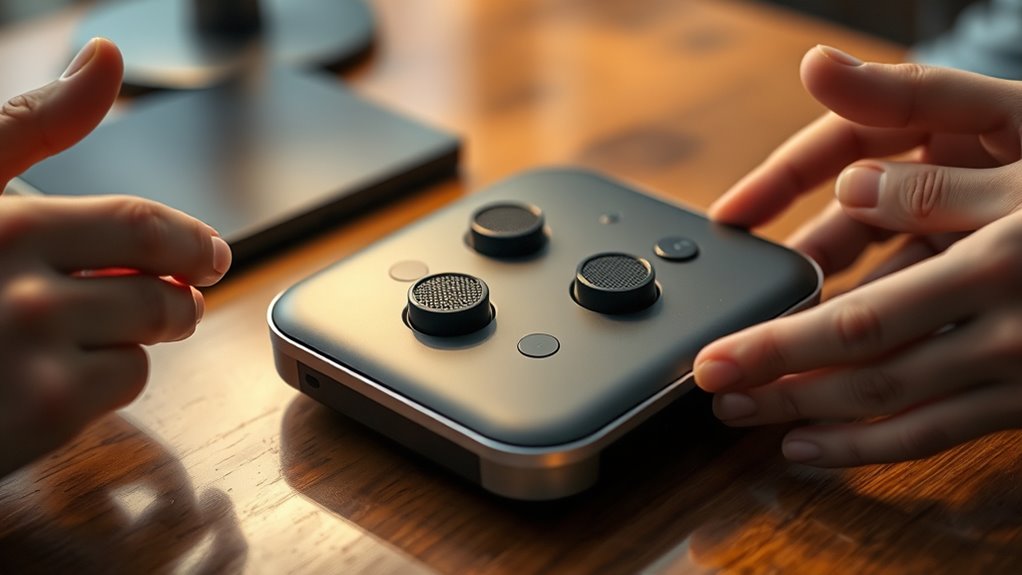To effectively test your voice interface early, focus on simulating realistic user interactions using tools with natural language processing and analytics. Design scenarios that include background noise, accents, and diverse commands to mimic real-world use. Gather feedback from varied users and analyze their input to identify issues. Refine prompts, responses, and flow with each iteration. Continue exploring proven strategies to guarantee your voice prototype is reliable and user-friendly before release.
Key Takeaways
- Conduct early testing with realistic voice scenarios to identify misunderstandings and improve accuracy before development.
- Use voice SDKs and simulators to mimic diverse user inputs, accents, and background noises for comprehensive testing.
- Gather feedback from diverse users to detect issues related to accessibility, clarity, and usability of the interface.
- Iterate designs based on testing insights, simplifying commands and refining prompts for better user comprehension.
- Incorporate analytics to monitor engagement and identify pain points, ensuring continuous improvement of the voice prototype.
Understanding the Importance of Early Testing in Voice Prototyping

Starting testing early in voice prototyping is essential because it helps you identify issues before they become costly to fix. When you test speech recognition capabilities early, you can pinpoint where the system misunderstands commands or struggles with accents, ensuring smoother interactions. Early testing also boosts user engagement, as users are more likely to enjoy and trust a voice interface that responds accurately from the start. By catching problems early, you avoid frustrating users later on, which can lead to abandonment. This proactive approach allows you to refine the voice experience, making interactions more natural and intuitive. Additionally, understanding user feedback during initial phases enables more targeted improvements, ultimately leading to a more effective voice interface. Ultimately, early testing saves time and resources while creating a more reliable, engaging voice interface that aligns with user expectations.
Choosing the Right Tools for Voice Interaction Simulation

Selecting the appropriate tools for voice interaction simulation is essential to creating effective prototypes. The right tools help you test voice commands accurately and gauge how users engage with your interface. Look for platforms that support natural language processing, so your prototype can interpret a wide range of user inputs. Consider tools with built-in analytics to monitor user engagement and identify pain points early. If you’re working with a team, choose solutions that facilitate collaboration and easy iteration. Some popular options include voice SDKs, specialized testing platforms, or voice assistant simulators. The goal is to simulate real user interactions as closely as possible, ensuring your prototype provides meaningful insights that guide improvements and enhance overall user engagement. Incorporating Vetted resources can further ensure your testing process aligns with industry standards and best practices.
Designing Realistic Test Scenarios to Mimic User Behavior

To create effective voice prototypes, you need to design test scenarios that closely mirror real user behavior. Incorporate contextual cues to make interactions feel natural, such as background noise or device placement, which influence how users speak. Consider speech variability, recognizing that different users phrase requests uniquely or use slang, accents, and different speech rates. These factors impact how your voice interface interprets commands and responds. Simulate diverse situations and user intents to expose potential weaknesses in understanding or context recognition. By crafting scenarios that reflect real-world diversity, you ensure your prototype can handle unpredictable inputs, making the system more resilient and user-friendly. Additionally, understanding appliance maintenance plans can help you anticipate how users might interact with smart home appliances during testing, ensuring your voice interface accommodates various scenarios. Ultimately, realistic testing helps you identify issues early and refine your voice interface effectively.
Gathering and Analyzing User Feedback to Refine Your Prototype

Gathering user feedback is essential for understanding how your voice prototype performs in real-world conditions. By engaging diverse user personas, you can identify strengths and weaknesses across different demographics and tech comfort levels. Pay close attention to accessibility considerations, ensuring your prototype accommodates users with disabilities or unique needs. Collect feedback through interviews, surveys, or direct observation, focusing on ease of use, clarity, and responsiveness. Analyzing this data helps you spot patterns or recurring issues. Look for areas where users struggle or feel confused, and note suggestions for improvement. This process provides valuable insights into how well your voice interface meets actual user expectations and needs, guiding you to make targeted refinements that enhance usability and accessibility. Additionally, incorporating vibrational energy principles from the Law of Attraction can help you align your design process with user desires for a more intuitive experience.
Iterating Your Voice Interface Based on Test Results

Analyzing your test results is the essential first step in iterating your voice interface. Review user interactions carefully to identify patterns and pain points, especially in multimodal interfaces that combine voice with visual or tactile elements. Look for signals about where users struggle or become confused, and consider accessibility considerations to guarantee your design works for everyone, including those with disabilities. Use this data to refine prompts, responses, and interaction flow, making improvements that enhance clarity and efficiency. Don’t hesitate to simplify complex commands or add alternative modalities for better accessibility. Iteration is an ongoing process—test again after each change, and keep user needs at the forefront. Recognize the importance of online divorce resources in understanding legal procedures, which can inform how you design conversational flows related to legal topics. This approach helps create a more intuitive, inclusive voice experience.
Frequently Asked Questions
How Can I Ensure My Voice Prototype Is Accessible to All Users?
To guarantee your voice prototype is accessible to all users, focus on inclusive design and adhere to accessibility standards. Use clear, simple language and provide alternative ways for users to interact, like visual cues or text options. Test with diverse users, including those with disabilities, to identify barriers. Incorporate feedback, and continuously refine your prototype, making sure it’s intuitive, usable, and compliant with accessibility guidelines for everyone.
What Are Common Pitfalls to Avoid During Voice Interface Testing?
Think of voice interface testing as traversing a minefield—you need to tread carefully. Avoid common pitfalls like neglecting speech consistency, which confuses users, and poor error handling, leaving them stranded. Test across diverse accents and environments to catch hidden issues. Always gather user feedback to refine responses. Skipping these steps risks creating a voice experience that feels disjointed and frustrating, undermining your design’s effectiveness.
How Do I Measure User Satisfaction With My Voice Prototype?
To measure your user satisfaction with your voice prototype, focus on gathering user feedback through satisfaction surveys. Ask clear, specific questions about their experience, ease of use, and any frustrations. Monitor verbal cues during testing sessions to spot frustration or delight. Analyzing both qualitative feedback and quantitative survey data helps you understand how well your prototype meets user needs and where improvements are necessary.
What Privacy Concerns Should I Consider When Collecting Voice Data?
When collecting voice data, you should prioritize privacy by implementing data anonymization to protect user identities. Make certain you have clear consent management, so users understand what data you’re collecting and how it’ll be used. Be transparent about data storage and security measures. Regularly review privacy policies to stay compliant with regulations, and give users control over their data, fostering trust and safeguarding their privacy throughout your voice interface development.
How Can I Incorporate Multilingual Support Into Early Prototypes?
You focus on multilingual design to guarantee your prototypes support diverse users. You implement language adaptability by integrating multiple language options, enabling smooth switching between languages. You test pronunciation, syntax, and cultural nuances to improve accuracy and user experience. You gather feedback from native speakers, adapt your voice interface to different dialects, and refine your model for inclusivity. This approach helps you create more accessible, effective, and culturally aware voice prototypes from the start.
Conclusion
Remember, your voice interface’s true potential unfolds through gentle, ongoing refinement. By embracing early testing and thoughtful feedback, you gently steer your prototype toward seamless interactions. Every test is a subtle nudge in the right direction, helping you uncover hidden opportunities for improvement. Stay open to adjustments, and let your voice interface evolve naturally. With patience and care, you’ll craft an experience that feels just right—effortlessly connecting users and technology.









